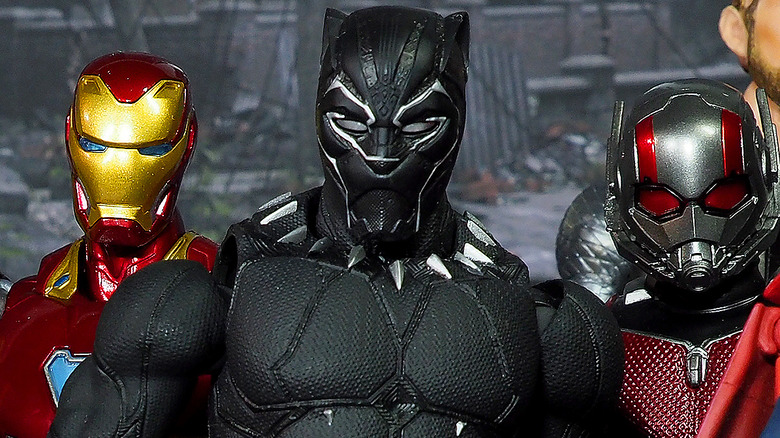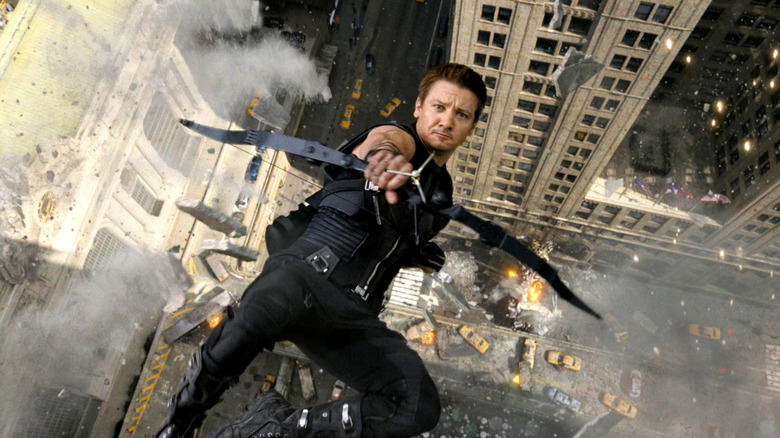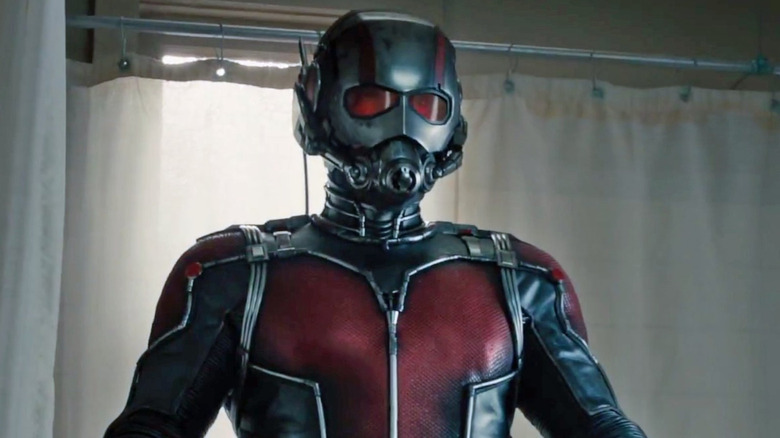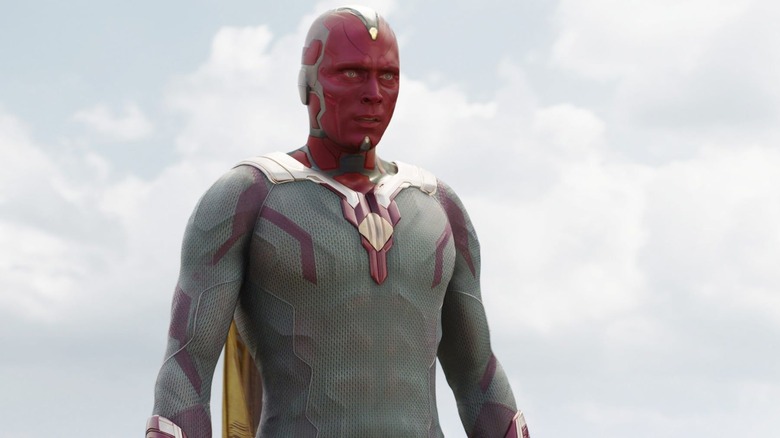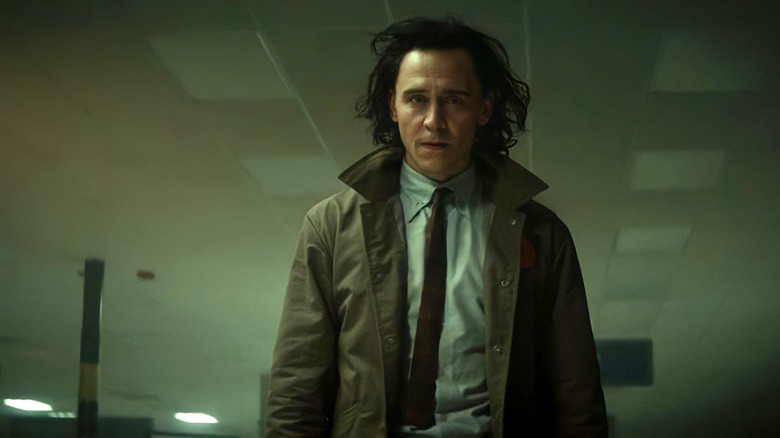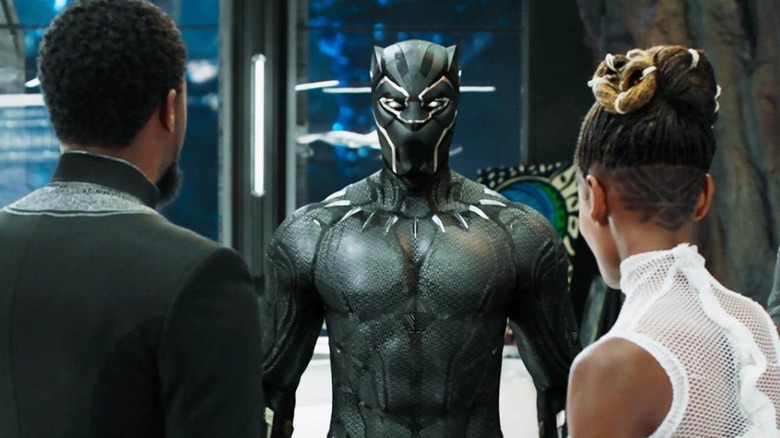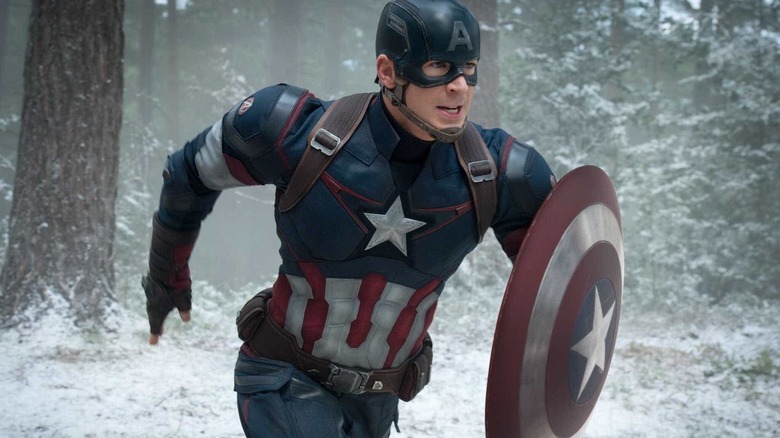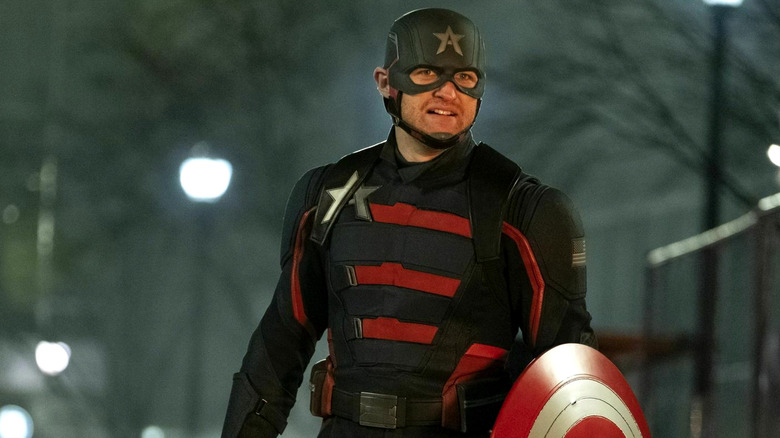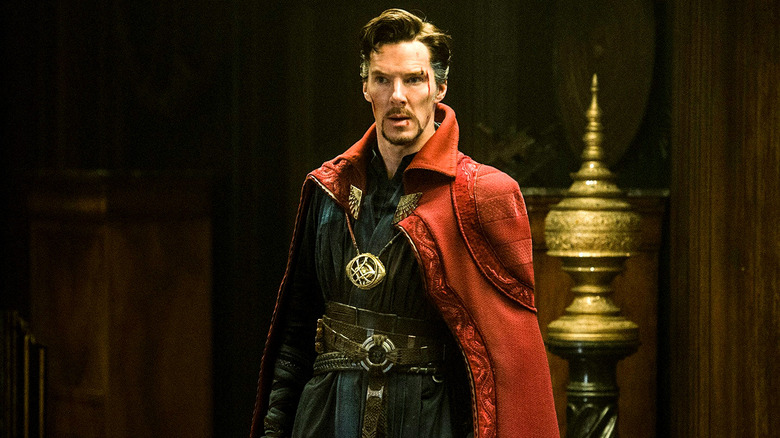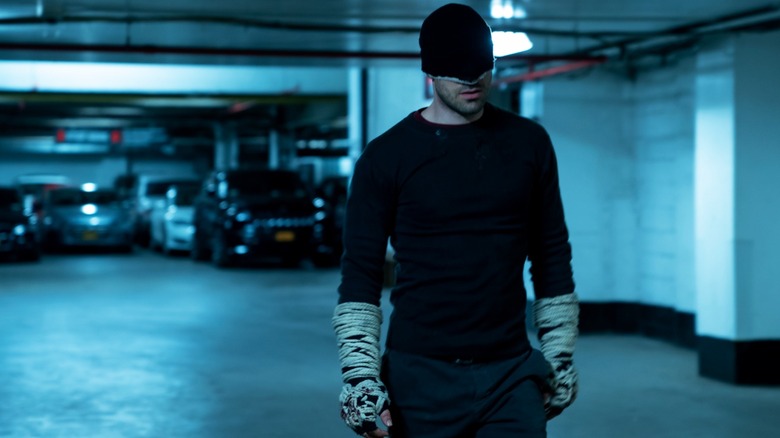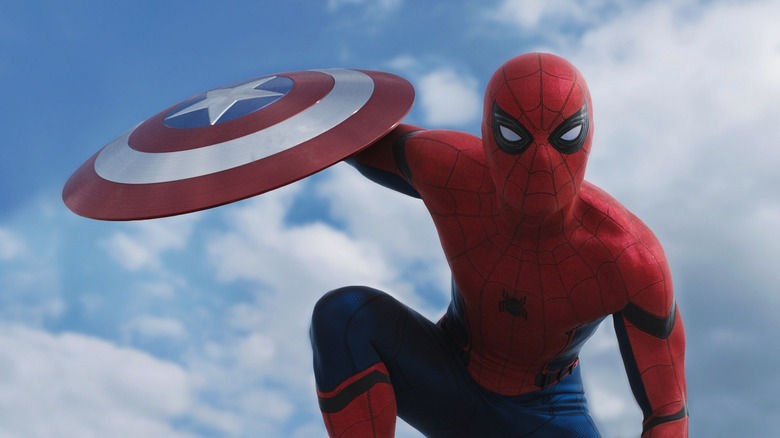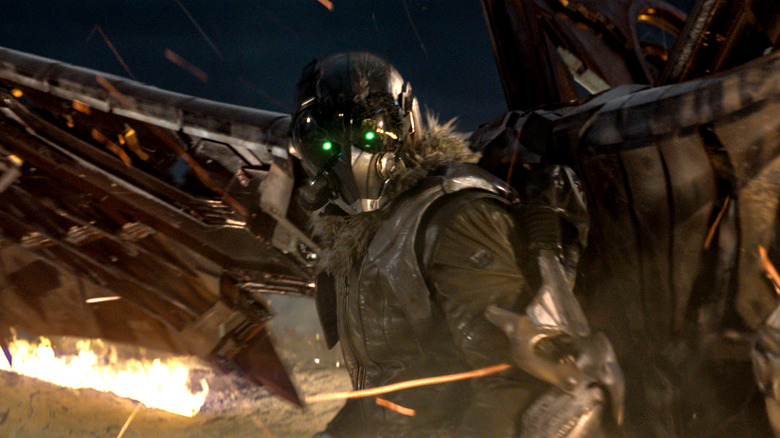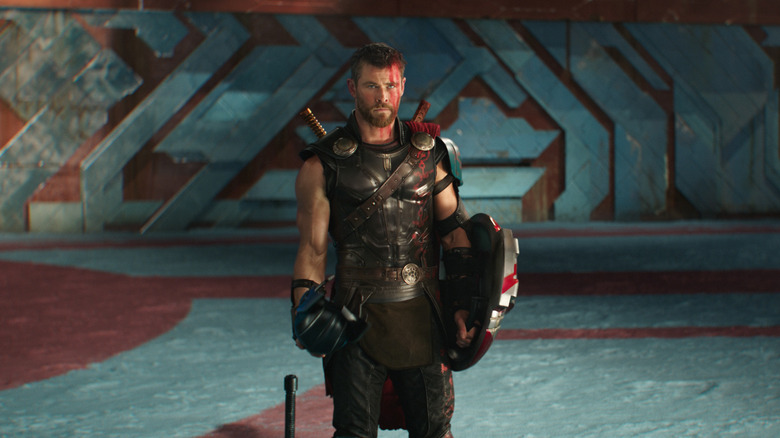The MCU: Unpopular Opinions About These Superhero Costumes
You can't have superheroes without costumes. It's part of the genre, and has been ever since a blue-and-red-clad Superman first took flight in "Action Comics" #1, way back in 1938. As superhero movies have gradually taken over much of pop culture in this century, the approach to costumes has varied and evolved over time. Some movies, like the "X-Men" franchise, have attempted to downplay the colorfulness of superhero garb, in an effort to make things look serious and "real." At times, the Marvel Cinematic Universe has flirted with that impulse as well, but as their cultural dominance has been secured, they've allowed things to get brighter and more fun where appropriate.
Looking back at the MCU's superhero costumes, some choices have been better than others, and conventional wisdom isn't always wise or correct. Here are some of the more unpopular opinions on how classic superhero costumes have been interpreted in the MCU.
Hawkeye should have worn a costume in "The Avengers"
After a quick cameo as a SHIELD agent in 2011's "Thor," Clint Barton (Jeremy Renner) would make his real debut as Hawkeye in "The Avengers," only to spend the first half of the movie under the thrall of Loki (Tom Hiddleston) and the Mind Stone in his scepter. He's freed from mind control in time to join the other heroes in fighting off the invasion of New York by the Chitauri, establishing him as a member of the Avengers going forward. Unfortunately, he never actually looks the slightest bit like a superhero.
The classic Hawkeye of Marvel Comics originally wore a purple and blue costume with a pointy Wolverine-style mask. The Hawkeye of the movie owes more to the version from Marvel's Ultimate Universe, but even that character is often depicted with a more distinctive costume than the movie version. In "The Avengers," Clint Barton basically just wears a tactical vest, pants, and combat boots. Sure, when he's with SHIELD at the beginning and then taken over by Loki, that outfit makes sense. But after that scene between him and Black Widow (Scarlett Johansen) on the SHIELD helicarrier, when he's just been freed from the mind control and declares that he's joining the fight, wouldn't it have been cool if he'd put on a new outfit to reflect that?
Years later, Renner's "Hawkeye" series on Disney+ would make a plot point out of the blandness of his costume. Clint Barton insists that his job is done better if he doesn't call attention to himself; Kate Bishop (Hailee Steinfeld) insists he has a branding problem.
While he shouldn't have worn buccaneer boots and a loincloth over his pants, something in blue and purple with a mask/helmet would have been a nice touch. After all, this is a world where Captain America (Chris Evans) is a great war hero, and he wore a red-white-and-blue outfit with a letter "A" on his mask. It's actually strange that nobody else seems to have been inspired by that look, when that would have been the perfect way to explain the proliferation of comics-style costumes.
Ant-Man's helmet should show his face
The outfit Scott Lang (Paul Rudd) wears as Ant-Man is based very closely on the classic Ant-Man costumes worn by both Lang and Hank Pym in the comics. However, the comics version always shows some of the character's face. In the movies, Scott is totally hidden, which makes Ant-Man look oddly alien and even creepy, which is especially strange for such a humorous, down-to-Earth character.
While it might be a bit more of a challenge for the digital effects artists (but surely one they're up to), Ant-Man would work better if he had a human face visible in his heroic identity. Plus, it would be Paul Rudd's face, which is not only one of the most handsome faces in movies, but also one of the most comedically expressive as well. On a peripheral note, many of the same things can be said of the Wasp (Evangeline Lily), who also wears a full-coverage helmet in the MCU, despite often wearing no helmet at all in the comics.
Vision has one of the best designs in the MCU
In the early days of the Marvel Cinematic Universe, everyone seemed much more reluctant to let superhero movies be as colorful as comics have always been. With Hawkeye in the aforementioned tactical vest, Black Widow in black leather, and even Captain America's patriotic colors as muted as possible, the palette felt oddly limited. Then came "Avengers: Age of Ultron," in which the Vision (Paul Bettany) made his big-screen debut.
"Age of Ultron" might be one of the least-beloved MCU movies, but Bettany's evolution from disembodied artificial intelligence to powerful android Avenger is one of the best things in it. From the moment the Vision first appears, he looks like he stepped out of a comic book panel, in a good way. With his green outfit, yellow cape, and crimson face, he shows that comics-style color schemes don't have to be toned down or discarded for live action adaptations. For those viewers who really love superheroes and their costumes, it was a huge step forward.
Loki's outfit in "Loki" is a disaster
There was a lot of great stuff in the Disney+ "Loki" series, but there were some missteps too. The introduction of the Time Variance Authority was a perfect follow-up to the reality-breaking events of "Avengers: Endgame," with alternate timelines becoming as much a part of the MCU as they are of the Marvel Comics Multiverse. Getting to meet Sylvie (Sophia Di Martino) and the other alternate Lokis was also a lot of fun, even if making the female Loki, Old Man Loki (Richard E. Grant), and Kid Loki (Jack Veal) completely different characters from the main Tom Hiddleston Loki did soften the weirdness of the character, compared to how complex he is in the comics. However, that's nothing compared to what was done to Loki by the end of the season, and costuming was a big part of that.
Due to the events of the show, Loki ends up wearing a TVA uniform: windbreaker, dress shirt, and skinny tie. That makes for an interesting contrast with his usual green and gold space-god garb, but it has uncomfortable implications in the context of the end of the series, when Loki begins to think he and Sylvie may be going too far and that He Who Remains (Jonathan Majors) and the TVA may be right about the need to control the timeline.
This is Loki, after all: the god of mischief and chaos. Anyone who's a fan of Loki loves him because of that mischief and chaos, so nobody wants to see him as a guy in a brown jacket and tie, arguing in favor of law and order. Marvel can surely bring the character back from the brink, but in that moment he felt more than a little broken.
Black Panther should wear a cape, like in the comics
In general, the costume Chadwick Boseman wore as Black Panther is great. It's also quite close to his comic book outfit, albeit with the kind of detailing and texture that works better in a movie. However, the Marvel Comics version of T'Challa often (but not always) wears a flowing black cape with his costume, giving him something of a Batman look. For a superhero who's also a king, it makes him seem a bit more regal than your average Marvel brawler.
Obviously, the Black Panther couldn't wear a cape all the time; it would be a disaster for jumping around on the roofs of cars and that sort of thing. But when he was acting in the role of Wakanda's ruler, it would have been cool to see Boseman in the cape. Plus, if it was part of the high-tech costume given to T'Challa by his genius sister Shuri (Letitia Wright), the cape could probably retract on command, so Black Panther could be ready quickly for situations that require more freedom of movement.
Captain America should have worn his mask more
Although there are variations throughout the franchise, the main costume Chris Evans wears as Captain America is pretty much perfect. It takes his classic design and colors and adds some realistic-looking details that make the suit look more tactical and less costumey (of course, fans also get to see the fully costumey version early in "Captain America: The First Avenger" when he's performing on stage). There's only one quibble with the outfit, and that's how often Steve takes off the helmet.
Leaving aside the fact that Cap's not invincible, and that helmet presumably provides some cranial protection, not wearing it also makes him feel a little less like the Star-Spangled Avenger he's supposed to be. Going around unmasked and unhelmeted feels less like a character-based choice, and more like the filmmakers being concerned that fans need to see Chris Evans' handsome face as much as possible. While it's true that MCU Steve Rogers has no secret identity to protect, the comics version of the character does, and that mask with the "A" is still an iconic look.
John Walker should have worn the same Cap costume as Steve Rogers
After Steve Rogers decides in "Avengers: Endgame" to live out his life in an alternate past with Peggy Carter (Hayley Atwell), the government chooses a soldier named John Walker (Wyatt Russell) to become the new Captain America. This is a story that also happened in the comics (although Steve's reason for leaving the role was different), but a big difference is that when Walker was Captain America in the comics, he wore the exact same costume Steve had worn. For "The Falcon and the Winter Soldier," they dressed Russell in a similar but distinct outfit that presages his later identity as USAgent.
The problem with this is that the whole John Walker story is about this guy who isn't as capable or stable as Steve Rogers tarnishing the reputation and the very idea of Captain America. The TV series does a good job of telling that story, but symbolically it would be a lot more effective if he wore the classic Captain America costume. Wyatt Russell's distinctive face and chin would still make it easy enough to tell that he's not Steve Rogers under the mask, but the visual similarity would feel more meaningful.
Doctor Strange has the best costume in the MCU
There are several factors that must be balanced in adapting a superhero costume for live action. Ideally, it should look recognizable as what the character wears in the source comic. On the other hand, it should look like real clothes that a person might wear, not an over-stylized cosplay outfit. Finally, it needs to contain whatever elements are important to the character and their story (a utility belt for Batman, a cosmic ring for Green Lantern), and it should also reflect whatever genre influences are important to the character — espionage for Black Widow and the Winter Soldier, mythological fantasy for Thor and Loki, etc.
No character's costume in the MCU balances all of these factors better than the distinctive garb worn by Doctor Strange (Benedict Cumberbatch). The blue tunic and red cloak are immediately recognizable from the classic version of the character, but with realistic detailing and texture in place of a big blue trident design and leggings. In addition to his Cloak of Levitation — which still has a high collar, but a less ridiculous one than the comics version — he has his big amulet, the Eye of Agamotto, from which he gets much of his power. Even beyond his resemblance to the classic Steve Ditko design, Strange looks like a modern-day wizard, which is exactly what he's meant to be.
The Netflix shows fumbled the question of who wears costumes and why
In the Marvel Comics Universe, the vast majority of superheroes wear costumes. Whether you're a grizzled badass like Wolverine or an upbeat goofball like Squirrel Girl, that's just the norm. So, when a superpowered protagonist in that world chooses not to wear a costume, that stands out. Jessica Jones, for example, was once the costumed superhero known as Jewel, but after being traumatized by her experiences with Killgrave the Purple Man, she lost interest in being a superhero, using her superpowers as a leather jacket-clad private investigator instead. Luke Cage, on the other hand, never had much interest in wearing a costume, just because he thinks it's silly.
Both Jessica and Luke, as played by Krysten Ritter and Mike Colter respectively, were part of the Netflix "Defenders" project, a tangential piece of the MCU where each hero got their own Netflix series, and then they all teamed up for "The Defenders." Unfortunately, some of what makes them unique was lost, because the whole thing was so gritty and uninterested in superhero aesthetics that they no longer stood out in that context.
The other two superheroes in the initial project were Charlie Cox as Daredevil and Finn Jones as Iron Fist (John Bernthal's Punisher was added later). In the comics, Daredevil wears a solid red superhero costume and Iron Fist wears a bright green and yellow one. On Netflix, however, Daredevil spent most of that first season fighting crime in regular black clothes with a black cloth tied over his face. Even when he finally got his costume, it was a mostly black tactical-looking affair with only dark red highlights. Similarly, Iron Fist never dressed in a full version of his costume, and mostly didn't wear one at all.
Jessica Jones' Jewel costume only made a brief appearance as a "ridiculous" outfit that she refused to wear, and Luke Cage's famous duds similarly made a brief, tongue-in-cheek appearance. In a world where nobody really dresses like a superhero, Luke Cage and Jessica Jones were just two more people who didn't (sorry, jeans and hoodies don't cut it), and that's a shame.
Spider-Man's moving eyes are the best-ever innovation for his costume
Spider-Man's arrival on the scene in "Captain America: Civil War" was a game-changer for the MCU, and also for live action depictions of Spider-Man. After Tony Stark (Robert Downey Jr.) shows up in Queens to recruit Peter Parker (Tom Holland), Spider-Man debuts during the movie's big superhero confrontation, appearing as if from nowhere to catch Captain America's shield out of the air, dressed in a costume made for him by Stark. Then something amazing happens: the eyes on Spider-Man's mask change size to focus on what he's looking at.
Spider-Man is one of the few classic superheroes whose costume has always covered his entire face. This can create a challenge for artists, because he still needs to be able to express emotion. For as long as he's existed, the standard way of dealing with this problem is to depict the oversized eyes of his mask moving and changing size as if they're real eyes—getting bigger for surprise, narrower for anger and so forth. For obvious reasons, however, nobody had ever attempted to depict that in live action, until the MCU.
The excuse that his costume is a high-tech Stark creation, combined with a line or two about how light filtration helps Spider-Man focus his overactive super-senses, enables his mask to be as expressive as it's always been on the page — and that allows for a friendly neighborhood Spider-Man who is far more human and relatable when he's in costume than any previous incarnation.
The villains in Spider-Man: Homecoming needed better costumes
Spider-Man's MCU costume is pretty much perfect, but his first couple supervillains have left something to be desired. The main villain of "Spider-Man: Homecoming" is the Vulture (Michael Keaton), but Shocker (Bokeem Woodbine) is also there as a secondary antagonist in the Vulture's employ. Unfortunately neither character really wears a costume, just a mix of streetwear and high-tech gadgetry that vaguely evokes each character's classic look. It's one thing for the Vulture to have metal wings, but it's kind of a shame to put that metal helmet with the glowing eyes on him, when just shaving Michael Keaton's head would really highlight his resemblance to the Marvel Comics Vulture. The MCU Vulture and Shocker are menacing, but they're just not as iconic as they ought to be.
Fortunately, the second movie fixes that problem. As Mysterio, Jake Gyllenhaal wears a visually striking version of the supervillain's classic bubble-headed green costume, which turns out to be just as special-effects-generated as his superpowers.
The "Ragnarok" outfit was Thor's first good costume
In his first few cinematic appearances, Thor (Chris Hemsworth) wore a version of his classic Asgardian garb from the comics: black leather armor inset with metal discs, a red cape, and even a winged helmet (in the first bit of the first "Thor" movie), although the widespread fear of letting superheroes look silly on film keeps him from wearing the helmet for long. Still, with the long blond hair and hammer, he's instantly recognizable as the comics character. On the other hand, the level of detailing on his armor is a bit much, and it misses the "Jack Kirby but real" aesthetic it seems to be aiming for, landing somewhere in "Lord of the Rings" knockoff territory. For the early MCU, it was fine, but it was never anything to write home about.
Then "Thor: Ragnarok" came along, and all of a sudden Thor was cool. Stripped of his hammer and exiled from Asgard by his estranged older sister Hela, Thor becomes a gladiator on the planet Sakaar. He gets a haircut (from Stan Lee, no less) and a new outfit, and it's totally a glow-up. No longer is Thor a cosmic prince in ceremonial-looking armor. Now he looks like the badass fighter he actually is, with simpler leather armor, cool war paint, and only one pauldron (a look that always works).
Of course, his appearance continues to evolve, and he'll definitely need another makeover after sinking into depression in "Avengers: Endgame." However, since his next appearance will be in "Thor: Love and Thunder," which is directed by Taika Waititi with costume designs by Mayes Rubeo (just like "Ragnarok)", we can trust that he'll once again look great.
